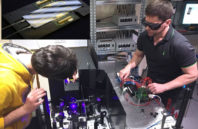An international scientific team has shown how an optical chip can simulate the motion of atoms within molecules at the quantum level. Data from the chip allows a frame-by-frame reconstruction of atomic motions to create a virtual movie of a molecule’s quantum vibrations.
Researchers exploited the natural mapping between vibrations in molecules and photons in waveguides. They simulated the time evolution of vibrational excitations in the harmonic approximation for several four-atom molecules. They then simulated coherent and dephased energy transport in the simplest model containing the peptide bond in proteins — N-methylacetamide — and simulated thermal relaxation and the effect of anharmonicities in H2O.
“We can program a photonic chip to mimic the vibrations of a molecule, mapping its components to the structure of a particular molecule, say ammonia, and then simulate how a particular vibrational pattern evolves over some time interval. By taking many time intervals, we essentially build up a movie of the molecular dynamics,” said University of Bristol physicist Anthony Laing, who led the project.

 (585) 768-2513
(585) 768-2513

